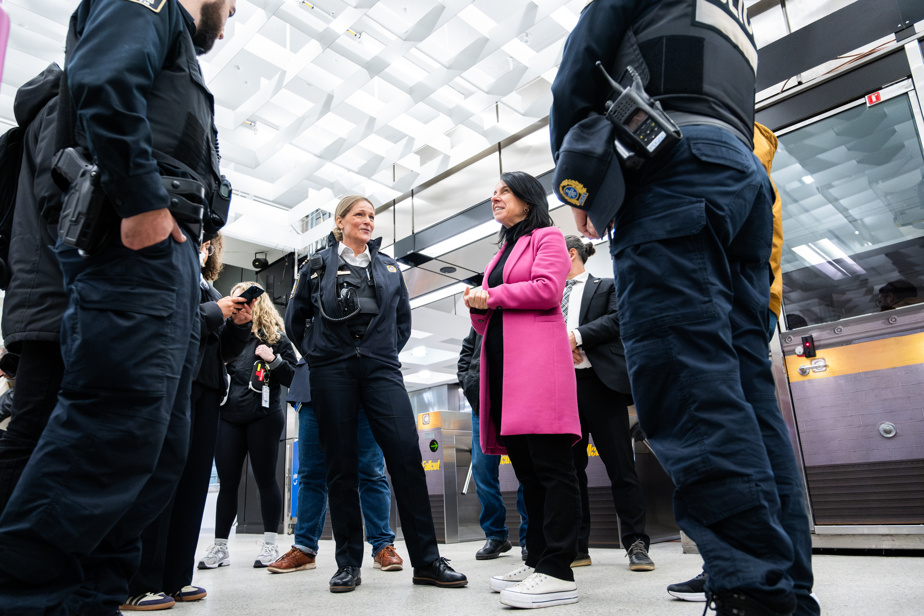Assault, people in crisis and increasingly harmful drug use: a dangerous cocktail that scares STM users. As summer arrives, insecurity in the transportation network is at the heart of the SPVM’s concerns, the mayor of Montreal and other municipal officials noted during a visit to the metro attended by The Press.
Wednesday morning, a lively discussion took place between the mayor of the metropolis, staff from the Metro Section of the Police Service of the City of Montreal (SPVM) and a handful of municipal elected officials at the neighborhood station located near Berri station -UQAM.
The mayor gets straight to the point. “What explains this feeling of insecurity right now? », she asks Joanne Matte, commander of the metro section at the SPVM.

PHOTO CHARLES WILLIAM PELLETIER, SPECIAL COLLABORATION
Intervention by SPVM police officers at Beaudry station, Wednesday
“The metro has always been a place where vulnerable people often go to beg, for example,” continues Valérie Plante.
Among other things, there was an increase in homelessness and addictions too, during the pandemic, according to the commander.
But it’s not just about the homeless anymore. We notice people struggling with mental health disorders. Some have become consumers over time. The booths are places of consumption, but also of sale of narcotics, recalls the commander.
“This is why the SPVM Metro Section changed its approach last November. We freed the police from emergency calls, which we gave back to the neighborhood stations. A new strategy which makes it possible to investigate, for example, drug trafficking in the metro, the source of many scourges. To focus on intelligence analysis, which subsequently enables targeted operations. »
Recently, Saint-Laurent station had suddenly become a center of consumption. “By sharing intelligence, we were able to target this problem. In three weeks, we coordinated with nearby injection sites and arrested resellers,” summarizes Joanne Matte.

PHOTO CHARLES WILLIAM PELLETIER, SPECIAL COLLABORATION
Joanne Matte, Commander of the Metro Section at the SPVM
We are no longer just answering calls. We can target crime more thoroughly.
Joanne Matte, Commander of the Metro Section at the SPVM
Montreal metro users also have their role to play by alerting the authorities of any incivility, offense or bad experience. “People are at the heart of this. What we say to our customers: report to us. You have to say it when something happens,” insists Éric Alan Caldwell, councilor for the City of Montreal in Mercier–Hochelaga-Maisonneuve.
Cleared from emergency calls
The Berri-UQAM station is crowded around noon. Herds of hurrying schoolchildren and workers emerge from the carriage as The Press accompanies the SPVM patrol officers and the two workers from the Mobile Mediation and Social Intervention Team (EMMIS) who are with them. They support officers in times when no offense has been committed. “Sometimes we know the people arrested by their first name. We can direct them to appropriate services,” explains a worker.

PHOTO CHARLES WILLIAM PELLETIER, SPECIAL COLLABORATION
Metro users at Berri-UQAM station
They know the Montreal metro like the back of their hand. “Today, Frontenac is quiet. Beaudry, for example…”, one of them points out to her police colleague. She is not mistaken: at Beaudry station, the train doors open to reveal a man lying on a bench. In his hand are three crack pipes. He does not hide to consume and barely bats an eyelid at the sight of peace officers. The patrol duo spoke briefly with the man before handcuffing him.
This arrest during the patrol would perhaps not have taken place if the staff were overwhelmed with emergency calls. “Since we have been freed from calls, there has been less carelessness. This visibility that we have now is very important,” said Sergeant Kevin de l’Etoile, of the Metro Section.
Living in space
Insecurity also reigns in public spaces adjacent to certain metro stations. We can think of Cabot Square, near Atwater station, or Place Émilie-Gamelin, near Berri-UQAM. Mayor Valérie Plante is aware of this, but remains optimistic. Restoring peace with a human and social approach is long-term work. The more people take advantage of these spaces, the more the feeling of security will return.

PHOTO CHARLES WILLIAM PELLETIER, SPECIAL COLLABORATION
The Mayor of Montreal, Valérie Plante
“One of our strengths in Montreal is our diversity and being able to ensure that public spaces are occupied,” according to the mayor.
The City, she recalls, launched several initiatives last winter to make the Place Émilie-Gamelin area more attractive for families, for example.
